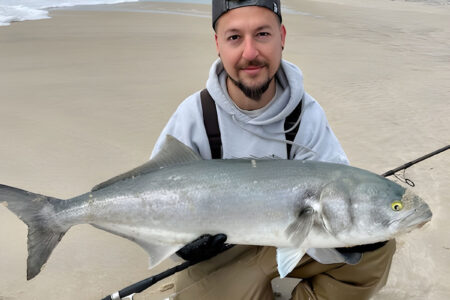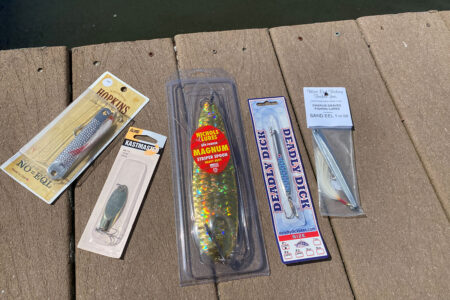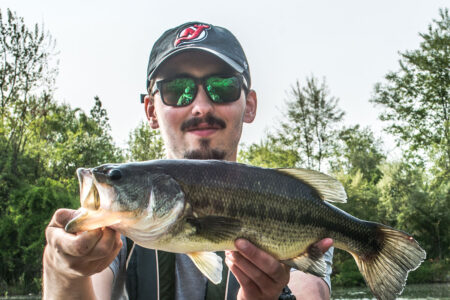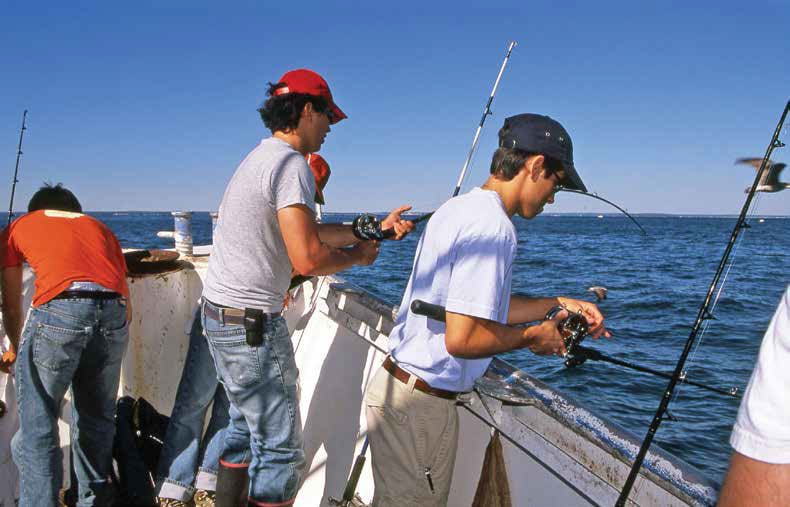
Hop aboard a partyboat to get in on the hot early-summer bluefish and striper bite. Here’s what you need to know.
Early summer means it’s time for the remainder of the spring-run stripers to overlap with the start of big bluefish staging in the large rips in eastern Long Island Sound. One of the easiest and most fun ways to get in on the action is to climb aboard a local party boat and work diamond jigsalong the southern New England coast.
Two of the better-known rips are the Race and Plum Gut at the mouth of Long Island Sound. These massive tidal areas, along with otherreefs both inside and outside of Long Island Sound, attract bluefish and bass from surrounding waters and anglers from three adjoining states.
You need a seaworthy craft here because the leading edge of big rips are marked by large, standing waves created when the current rushes up and over reefs located far below. When a stiff breeze opposes a strong tide, the seas along the rip line build and can be menacing. However, conditions that are treacherous for personal small craft are just business-as-usual for large party boats.
Fishing on a party boat is one of the most carefree types of fishing anywhere. The captain does the driving and makes the decisions about the fishing. And the mates do the hands-on work, including rigging tackle, giving instruction, untangling lines, gaffing or netting fish and filleting your catch. All you need to do is pay a fee, catch your fish and enjoy the camaraderie.
The Basics
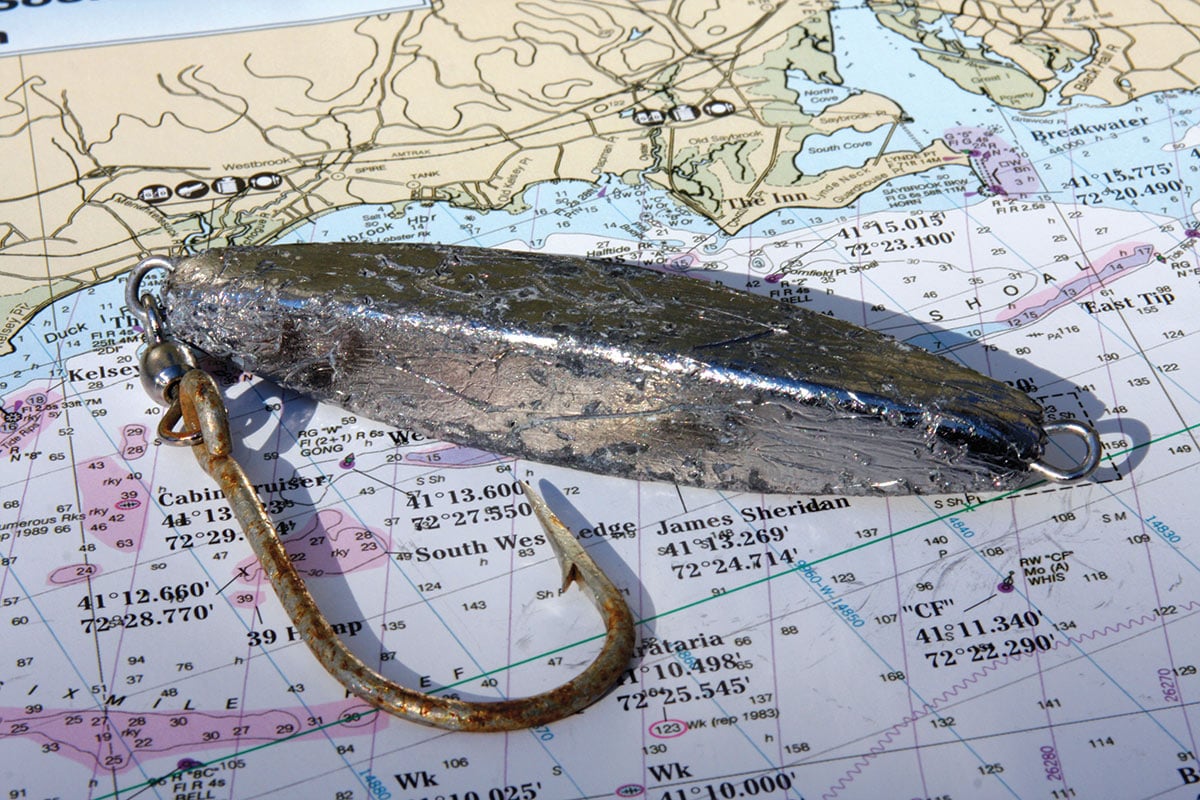
If you’re reading this, chances are you’re new to the party boat scene and want to be successful, as well as fit in with the “regulars” and sharpies onboard, so there are some things you need to know. Otherwise, you, the mates, and everyone around you will soon become frustrated. So let’s start at the beginning.
Party boats typically range from about 60 to 115 feet long and usually offer one or two 6-hour trips per day, with sailing times at about 6:00 AM and 1:00 PM. Some take reservations, but most are on a first-come basis. That means you should arrive at the dock early, especially on weekends. After buying a ticket and boarding a boat expect a 30- to 45-minute ride to the chosen grounds, as the captain will take you to where the bite is best, given the conditions and fish population.
The fee for a half-day trip ranges from about $64-$80 and includes terminal tackle. The mates may collect a small lure deposit, which you’ll get back at the end of the trip—that is, if you don’t lose your rig. Any lost tackle must be paid for on the boat.
Rigs and Tackle
You may bring your own deep-sea rod or you can rent one onboard for about $7. If you bring your own outfit, you’ll need a 6½- to 7-foot medium-heavy-action boat rod and substantial, conventional-style 3/0 to 4/0 reel, such as a Penn Senator or Shimano Torium 16. Although a levelwind reel is easier to use, especially for a youngster or a novice, the levelwind mechanism slows the free-spool speed and therefore slows the drop of the jig. Drop speed is extremely important for keeping your jig and line as vertical as possible, which fishes better and reduces bottom hangs. Load your reel with 40- to 50-lb monofilament or braid.
“Using the right type of line is helpful,” says Capt. Tony Notaro II who runs the Lucky Lady from Clinton, CT.“There are a lot of people who love braided line, and that’s fine, but on a partyboat it can be problematic as it’s much more difficult to untangle than mono. You are more than welcome to use braided line on our boat, but if you get tangled it takes longer to get you back to fishing.”
If you do use braid, which is helpful for vertical fishing due to its low stretch and minimal water drag,many mates prefer you top-shot it with about 30 feet of 50-pound mono, which is much easier for them to handle and untangle. Before heading out on any party vessel, check with the boat management about their line-type policy.
Why Diamonds?
For fishing performance, it doesn’t get any better than diamond jigs. Diamonds can plummet in the strongest current, yet they wobble irresistibly like a fleeing baitfish when retrieved. During white-hot action, jigs have a speedy turnaround time because you don’t need to rebait, and there’s no mess. Use the smallest jig possible given the wind, current and depth. For ferocious rips around eastern Long Island Sound, carry jigs of at least 8 to 12 ounces.
When preparing diamond jigs intended to fish rugged bottoms and toothy critters, always replace a treble hook with an 8/0 single. Trebles snag bottom, lobster gear and other lines more easily, and make unhooking fish difficult and dangerous in a pitching craft. They’re also more harmful to the fish during catch-and-release.
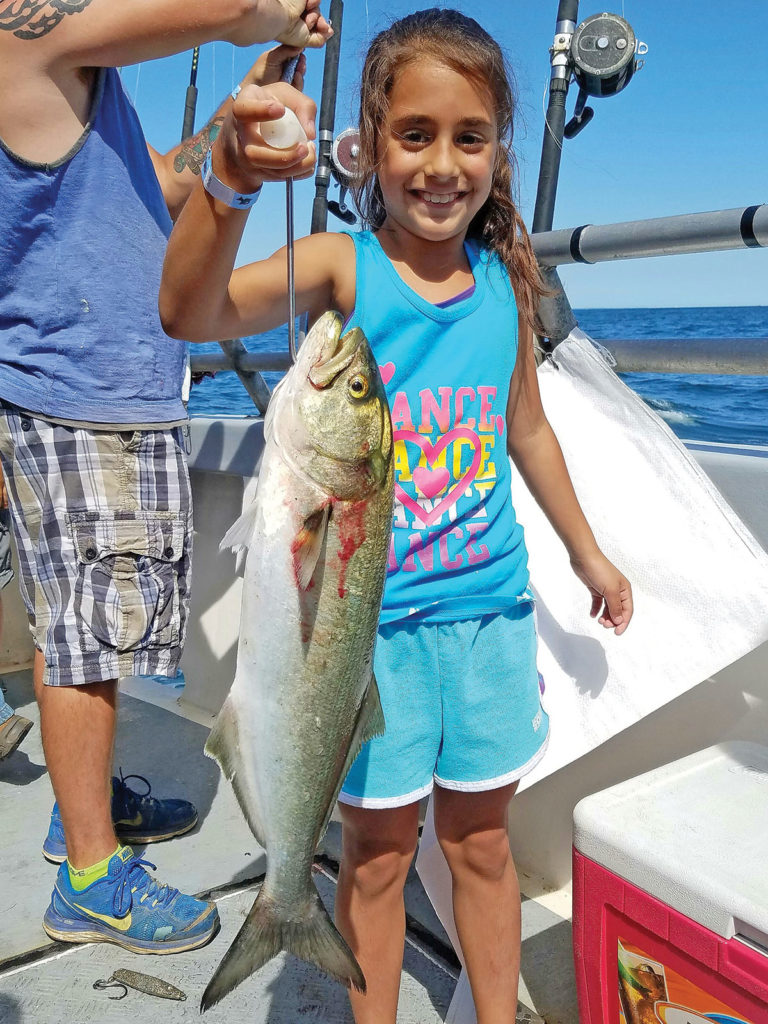
How to Fish ’em
Once a party boat arrives at a rip or reef, the captain, watching his depthfinder, will locate a bottom drop-off ahead of the rip line and turn the vessel broadside to the current before stopping. By now you should have selected an open/free spot along the rail and have your rod and jig at the ready. But wait until the captain sounds the horn or otherwise announces “okay to fish”—when the boat is at a dead stop—before free-spooling your rig into the depths.
Fishing diamond jigs, which some party boats like the Black Hawk now offer, requires a different technique than the stationary-style used in baitfishing for blues and bass. After quickly free-spooling your jig until it bumps bottom,immediately engage the reel and start your action.
“The best approach,” says Capt. Kerry Douton of the charterboatDot-E-Dee, “is to hit bottom, retrieve the diamond about 10 fast cranks up, drop back down and hit bottom again. And you keep doing that until it scales out—when you get too much line out and the jig gets diagonally away from the boat—then you have to reel all the way in and start again from the surface. A vertical drop is always best if you can maintain it.”
The boat will drift up the shoal, across its crest, anddown the backside. For the best chance at hooking a fish, you must keep your jig working as close to the bottom as possible—that’s where the fish are feeding. If your rig snags in the rocks, call for the mate, hold the rod tightly and let the line part. Never grab the line and take a turn around your hand; that’s a good way to lose your fingers. Reel in the broken line and buy a new jig from a mate or tie on your own.
Fighting your Fish
When a bluefish or bass grabs a jig you’re in for a good fight and possibly some tangles as it darts around your shipmates’ lines. Don’t loosen the cinched-down drag to “play” the fish. This isn’t light-tackle angling—just winch it to the surface as quickly as possible. The more freedom you allow the fish the more snarls it could create around other lines. Once the fish surfaces, don’t try to lift it out of the water or onboard. Call for a mate who’ll hustle over with a long gaff—or net if it’s a striped bass—and land the fish for you.
At the end of each drift or pass, the captain sounds the horn again, and everyone immediately reels in his or her line. Don’t delay because you want to make “one more drop.” The boat can’t run back up-tide until all hooks are aboard. This drop-drift-and-run procedure is followed until the last drift of the trip, which the captain signals by blowing the horn several times in succession or announcing over the p.a. system.
What Else You Should Know
To make your trip more enjoyable bring a camera, sunscreen, snacks, non-alcoholic beverages, rain jacket, cap, sunglasses, motion-sickness medication and wipe rag. You’ll also need some extra cash.For a dollar or two, you can buy a burlap sack to hold your catch while onboard. Another dollar or two enters you in the pool for the biggest fish. For about a dollar per fish, the mates will fillet, skin, wash and bag your catch during the return to port. Boat rules prohibit you from cleaning your fish onboard, although you may carry them whole off the vessel. And when stepping off the boat, remember that this is a service industry, so be a good sport and tip the mates 15%-20% for their hard work.
Party boat fishing is a great way to go deep-sea fishing for a minimal expense. You’ll almost always come home with fish for the grill. And you’ll meet many interesting characters who share a passion for southern New England’s hot summer bluefish and bass run.
